 Relevant History welcomes Loretta Proctor, who has always had a love of the art of the Pre-Raphaelite painters. This led to writing The Crimson Bed set in Victorian London, a story of two failed artists, partly based on the life and character of Rossetti. She began writing in the 1970s, had poems and articles published, winning a prize with a one-act play. She left writing to bring up a family and took up counseling work. After retiring to Malvern, UK she began to write again and has had four books published, one of which is to be translated into Greek this year. For more information, check her web site and blog, and look for her on Facebook.
Relevant History welcomes Loretta Proctor, who has always had a love of the art of the Pre-Raphaelite painters. This led to writing The Crimson Bed set in Victorian London, a story of two failed artists, partly based on the life and character of Rossetti. She began writing in the 1970s, had poems and articles published, winning a prize with a one-act play. She left writing to bring up a family and took up counseling work. After retiring to Malvern, UK she began to write again and has had four books published, one of which is to be translated into Greek this year. For more information, check her web site and blog, and look for her on Facebook.
*****
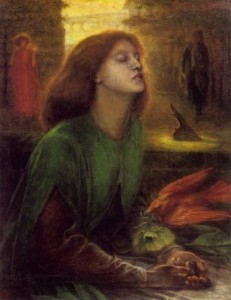 There is something about the art of Dante Gabriel Rosetti which captivates the viewer, drawing them into a magical world. His first paintings—small, intimate, intense—are filled with meaning and mystery, exuding a sense of enthralment, drawing us into an enigmatic archetypal land, long forgotten yet strangely familiar. His favourite subjects at that time were myths and heroic stories, in particular Le Morte d’Arthur and the poetry of Tennyson. These subjects haunted this romantic young man; tales of knights, troubadours and their ladies, ideals of pure, untainted love.
There is something about the art of Dante Gabriel Rosetti which captivates the viewer, drawing them into a magical world. His first paintings—small, intimate, intense—are filled with meaning and mystery, exuding a sense of enthralment, drawing us into an enigmatic archetypal land, long forgotten yet strangely familiar. His favourite subjects at that time were myths and heroic stories, in particular Le Morte d’Arthur and the poetry of Tennyson. These subjects haunted this romantic young man; tales of knights, troubadours and their ladies, ideals of pure, untainted love.
The Pre-Raphaelite Movement
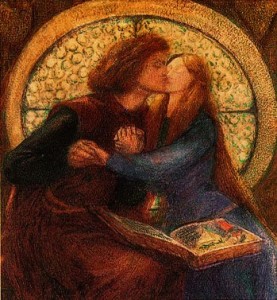 Rossetti, Millais, and Holman Hunt began the movement which they named the Pre-Raphaelite Brotherhood intending to challenge the stultified, colourless art which abounded at the time in the Royal Academy in London. To have one’s paintings hung at that grand institution was the acme of every painter’s efforts; it meant prestige, acceptance and fame. With the fire and idealism of youth, these young men chose not to follow the trends of their time.
Rossetti, Millais, and Holman Hunt began the movement which they named the Pre-Raphaelite Brotherhood intending to challenge the stultified, colourless art which abounded at the time in the Royal Academy in London. To have one’s paintings hung at that grand institution was the acme of every painter’s efforts; it meant prestige, acceptance and fame. With the fire and idealism of youth, these young men chose not to follow the trends of their time.
Their aim was to paint straight from nature, including every detail as they saw it. They wanted to return to the golden age of fresh, vibrant painting that existed before the art of Raphael. In order to achieve this luminosity in their work, the artists prepared their canvas with white paint and then slowly and painstakingly painted thin layers onto this so that the underlying white raised the colours and shone through. Their pictures appeared so radical at the time that the art world was horrified and they were mocked, derided and insulted.
A Knightly Love
The ideal of a pure love always fascinated Rossetti. Rossetti was a cultured, educated man whose father brought him up on the classics. He was named Gabriel Dante after the great philosopher and writer from Florence, Dante Alghieri, the writer of The Divine Comedy and the Inferno. Rossetti identified himself with his hero and altered his names, giving preference to Dante. The famous meeting of Dante Alghieri with young Beatrice Portinari on a bridge in Florence was to become something of a leitmotif for Rosetti’s own life and loves.
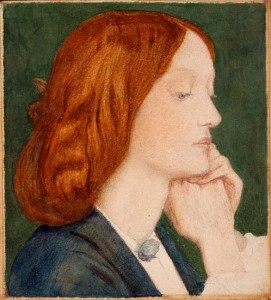 When Rossetti met his Beloved in the shape of Lizzie Siddal, he loved her with the passion of an Italian soul. Lizzie herself was a rather prim, cold looking, delicate, fragile being. Something in her stirred the heroic masculinity in Gabriel, the need to protect and adore. They met in 1849 and became engaged in 1851, but it was ten years from their first meeting and first flush of passionate love for one another before they eventually married.
When Rossetti met his Beloved in the shape of Lizzie Siddal, he loved her with the passion of an Italian soul. Lizzie herself was a rather prim, cold looking, delicate, fragile being. Something in her stirred the heroic masculinity in Gabriel, the need to protect and adore. They met in 1849 and became engaged in 1851, but it was ten years from their first meeting and first flush of passionate love for one another before they eventually married.
It has often been questioned as to whether they became intimate sexually. We assume so with our modern minds because sex seems to be an obvious when two people are together. In the mid-Victorian times, engagements could be very long and often were not consummated sexually for fear of pregnancy and compromising a ‘decent’ woman. The couple was expected to remain chaste, a girl to be a virgin when she did eventually make it to the altar. There are many indications that their love was never really consummated until their marriage in 1860 when Lizzie fell pregnant quite quickly. It’s true, contraception was known in some form or other then, but everything in Rossetti’s nature tended toward a disinterest in sexuality. He never frequented the cigar divans like his friends and if he did, sat and smoked, simply looking on with a detached curiosity.
Rossetti’s Reluctant Marriage
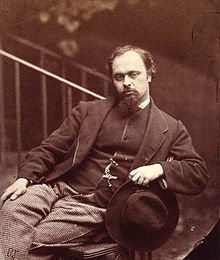 Lizzie was a rather sickly woman who suffered from her nerves, scarcely helped by Rossetti’s reluctance to be tied down in marriage. Her reputation was already ‘lost’ through becoming an artist’s model, frequently alone with him in his studio. Eventually, Rossetti realised that he no longer loved his ‘Beatrice,’ that the ideal was unsustainable by the normal human soul. Lizzie also knew this, and there were frequent rows over frequent but unresolved promises that they would marry. Rossetti even borrowed £10 from Ford Madox Brown in order to marry Lizzie, but the money was somehow spent and the marriage never took place.
Lizzie was a rather sickly woman who suffered from her nerves, scarcely helped by Rossetti’s reluctance to be tied down in marriage. Her reputation was already ‘lost’ through becoming an artist’s model, frequently alone with him in his studio. Eventually, Rossetti realised that he no longer loved his ‘Beatrice,’ that the ideal was unsustainable by the normal human soul. Lizzie also knew this, and there were frequent rows over frequent but unresolved promises that they would marry. Rossetti even borrowed £10 from Ford Madox Brown in order to marry Lizzie, but the money was somehow spent and the marriage never took place.
His friends simply couldn’t understand what he was up to. Lizzie was by now twenty-nine years old, penniless and more or less an invalid of her nerves, not a happy position for a woman in those days. Rossetti hadn’t the heart to cast her aside but wasn’t dishonest enough to marry without love. They were both deeply unhappy and it showed in many of his pictures. His muse still flowed, but they are melancholic statements of separation and parting.
Paintings depicting Sadness and Separation
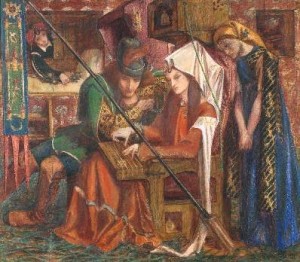 Jan Marsh, in her brilliant biography of Rossetti, points out that this showed clearly in many of the paintings he executed at the time. One of the most striking is The Tune of Seven Towers where two lovers sit together apparently lost in music but both sunk in their thoughts, the companion beside the lady immensely sad. Across the lovers is a weird lance which seems to negate and separate the whole picture.
Jan Marsh, in her brilliant biography of Rossetti, points out that this showed clearly in many of the paintings he executed at the time. One of the most striking is The Tune of Seven Towers where two lovers sit together apparently lost in music but both sunk in their thoughts, the companion beside the lady immensely sad. Across the lovers is a weird lance which seems to negate and separate the whole picture.
Rossetti and Lizzie parted eventually but Lizzie fell so ill that Gabriel, in a fit of guilt, rushed to her side and married her quietly on Friday April 13th, a peculiarly inauspicious date. There was little joy in it, and he became less and less seen at home. Lizzie suspected him of infidelity. This may or may not have been true but there is no doubt that his thoughts and love were no longer with her. In a fit of darkness and depression, she eventually took her own life. A sad ending to a great love but also a moral tale that human beings cannot sustain ideals but need to relate to their own humanity. Rossetti was incapable of doing this and lived his life in a slowly dissolving, slowly darkening dream filled with guilt and self-doubt.
*****
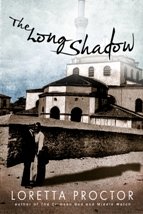 A big thanks to Loretta Proctor. She’ll give away a trade paperback or electronic copy of The Long Shadow to someone who contributes a comment on my blog this week. I’ll choose the winner from among those who comment by Friday at 6 p.m. ET. Delivery for the trade paperback is available within the UK only.
A big thanks to Loretta Proctor. She’ll give away a trade paperback or electronic copy of The Long Shadow to someone who contributes a comment on my blog this week. I’ll choose the winner from among those who comment by Friday at 6 p.m. ET. Delivery for the trade paperback is available within the UK only.
**********
Did you like what you read? Learn about downloads, discounts, and special offers from Relevant History authors and Suzanne Adair. Subscribe to Suzanne’s free newsletter.
